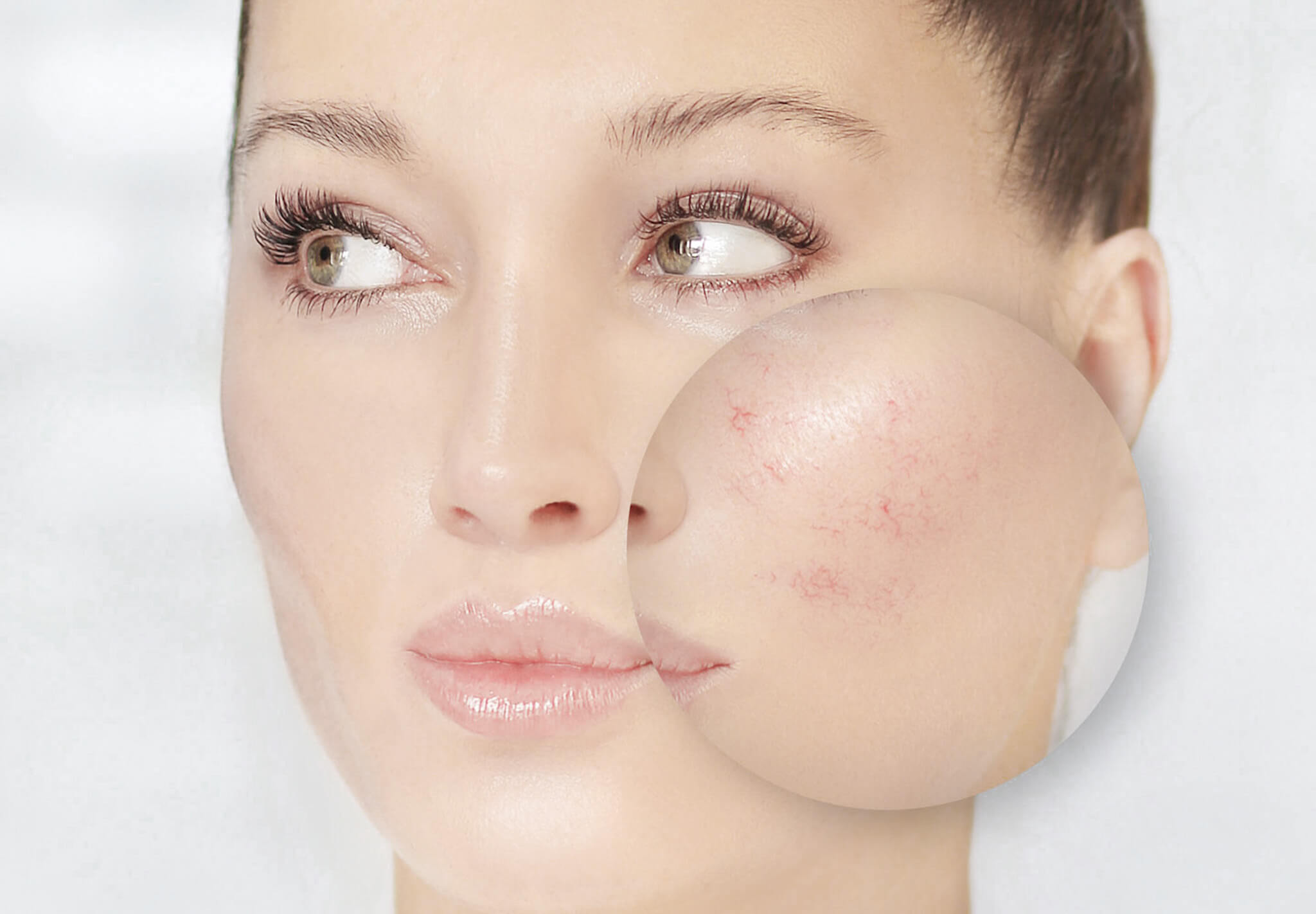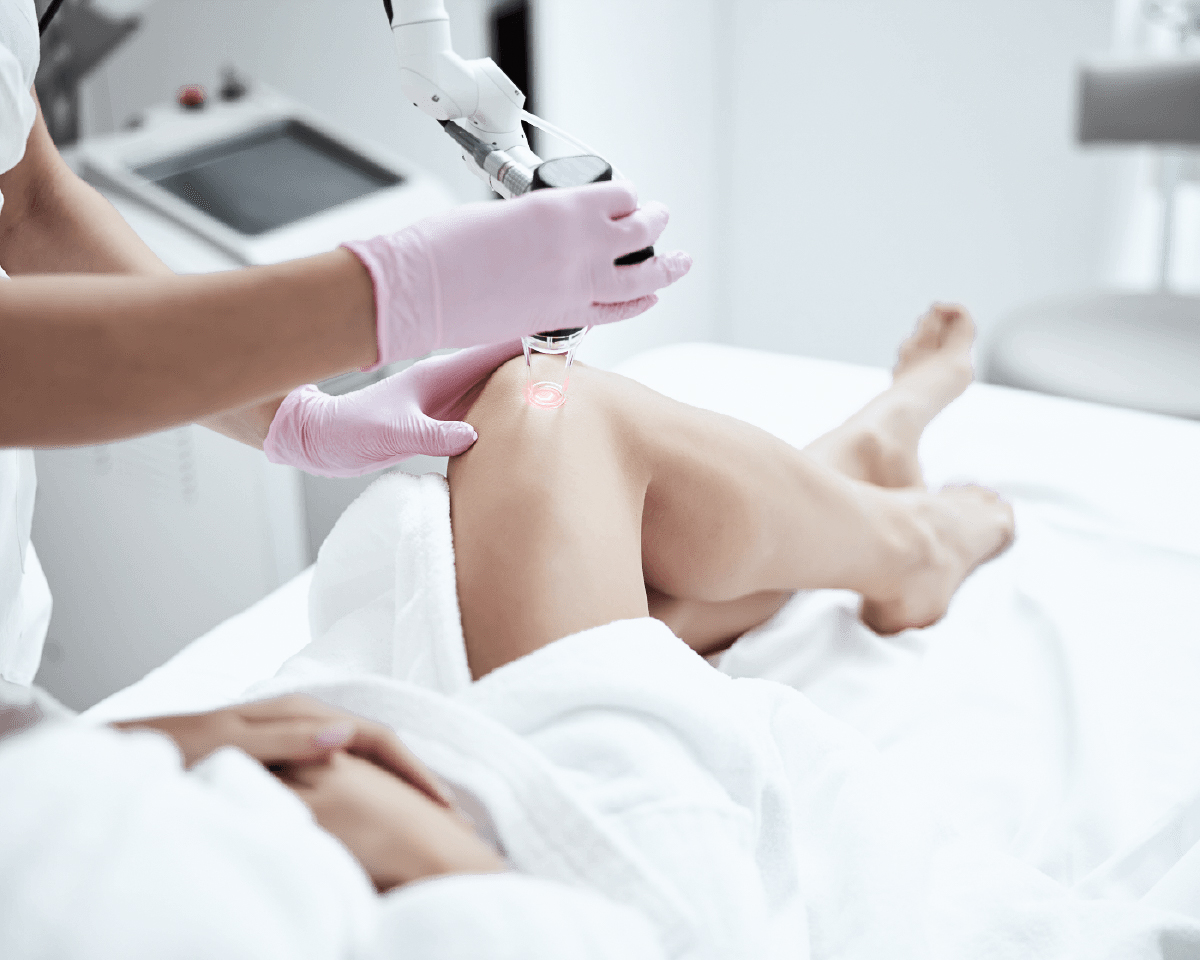Vasodilatation
The best and most professionally accepted treatment for vasodilatation is laser.
Laser vasodilatation is a simple, quick and effective way to treat superficial veins.
Find out our prices, scroll down or click here!
What are vasodilatations?
The lives of millions of women and men are plagued by varicose veins on the face and legs. They can take many different forms: thin, discrete lines (broom veins), a web-like maze, or branches branching off a tree trunk. The spider vein is so named because it resembles a star or spider with several tiny veins branching out from a central point. It is estimated that more than 75% of women over the age of 18 have some form of varicose vein disease.
In our clinic, vasodilatations of 0.5-1 mm in diameter are treated with a long-pulse Nd:Yag laser (Italian Quantasystem). The injection method used by vascular surgeons, sclerotherapy, is less effective for capillaries and cannot be used on the face, knees or ankles.

Is vasodilatation bad for your health?
A vasodilatation is superficially located under the skin and is much smaller than a varicose vein. Because the vasodilatation is dark and superficial, it is a major source of embarrassment for most women. It should be noted that a varicose vein is harmless and does not cause any symptoms. The lesion is only cosmetic.
What causes vasodilatation?
The development of vasodilatation is typically caused by abnormal blood flow and weakening of the vessel walls. Any condition or activity that puts pressure on the veins (such as obesity, prolonged sitting or standing) can contribute to the development of varicose veins.
The incidence of vasodilatation increases with age and is therefore common in old age. There is also a genetic reason for the development of vasodilatation, as it runs in families. The onset of vasodilatation is common in pregnancy, especially in the second trimester, and has been associated with increased levels of the female sex hormone oestrogen. Estrogen weakens the walls of the veins and may contribute to the development of vasodilatation.

What are the non-surgical options for treating vasodilatation?
The most conservative treatment for vasodilatation is the wearing of support stockings (also known as compression stockings), which are supportive in shape. Such stockings are usually available in a variety of styles and colours in any health food shop. The stocking/tights may end below the knee or above the knee. Unfortunately, however, once vasodilatation has developed, it does not disappear even with stockings.
Other treatment options include proper skin care, losing weight if you are overweight, regular exercise (especially walking), avoiding prolonged sitting or standing, and keeping your legs elevated when sitting or sleeping. People who stand for long periods should take breaks to rest their legs.
What is the role of lasers in the removal of vasodilatation?
Laser is the best and most professionally accepted treatment for vascular lesions. Laser vasodilatation is a simple, fast and effective way to treat superficial veins. Laser therapy has been used in medicine for over 30 years. Thanks to technological advances, several types of lasers have been developed. Lasers work with a highly focused beam of light. When treating veins, the wavelength of the light is chosen according to the pigment in the blood. The laser heats up the tiny veins and destroys them. The laser light is focused and does not damage the surrounding tissue. The vein is absorbed into the body and disappears in 4-6 weeks.
What type of laser is used to treat vasodilatation?
The most commonly used laser to treat vasodilatation is the long-pulse Nd:Yag laser system. It is a hand-held device with a cooling unit at the end to minimise the discomfort associated with the treatment. In our practice, we use the Italian-made QuantaSystem Q-Plus Star 1 long-pulse Nd:Yag laser.
How does the laser work?
The Nd:Yag laser penetrates through the skin into the surface blood vessels. The heat generated by the laser melts the blood in the vessel, causing it to collapse and separate from its surroundings. Over the following weeks, the blood disappears and is removed by the body's own phagocytes. Newer laser therapies allow a precise dose of energy to be delivered to each blood vessel without causing the slightest damage to the surrounding tissue.

Is laser treatment painful?
During the treatment, you may feel a slight tingling sensation while the laser is working. If anyone experiences any pain, a local painkiller will be administered 20 minutes before the procedure.
How does the patient feel after the laser treatment?
Soon after the procedure, you may feel a slight swelling on your skin, which will disappear within the next 2-4 hours. The affected area may become slightly red and bruising may sometimes occur.
Do I need to take any precautions after laser treatment?
After laser treatment, it is highly recommended to stay out of the sun. Wearing support stockings helps the healing process. Pain is minimal and the patient can use any over-the-counter painkillers. There is no recovery time after treatment and you can return to normal activities immediately.
What are the side effects of laser therapy?
The skin over the affected veins will be red, a bit like it's been scratched by a cat. This usually goes away in the next two days.
When can I go back to work after laser treatment?
Patients are encouraged to return to their normal activities immediately.
How many treatments will I need?
Depending on the size and number of veins, you will need 2-4 treatments. Treatments are usually carried out every 4-6 weeks.
How long before the results are clear?
The results of vasodilator laser treatment are not immediately visible. After the laser treatment, the blood vessels under the skin gradually change from dark blue to light blue and disappear in 2-6 weeks. Most patients are very happy with the procedure and are relieved that they no longer have to cover up unsightly veins. However, in some cases the final result is not clear for months. The treated areas are noticeably clearer and in most cases the skin continues to improve with each treatment.
What are the advantages of laser treatment over sclerotherapy?
It can have far fewer side effects.
Less traumatic to the surrounding skin than sclerotherapy.
The treatment takes much less time.
Less painful than sclerotherapy.
Healing is immediate.
Laser therapy can also be used on the face.
Post-treatment information
After treatment, hot baths, sunbathing and saunas should be avoided for 3-4 weeks. In case of scabs, do not scrape the scar. If it is not hereditary, avoiding excess weight, sauna, hot baths, tanning beds, strong sunlight, prolonged standing and sitting, and wearing comfortable shoes and clothes may help prevent further recurrence of the scab.
What are other ways to treat vasodilatation?
If conservative treatment fails to achieve adequate symptom relief, or if the appearance of the veins bothers the patient, other treatments may be considered, depending on the patient's general health. Depending on the size and location of the veins, the following treatments may be considered:
Sclerotherapy: this method is not used for varicose veins, only for varicose veins. The procedure involves injecting a concentrated sodium chloride solution into the vein with a thin needle. The solution irritates the veins and causes them to collapse. Over time, the blood vessel turns into a scar tissue and disappears. In most cases, several treatments are needed to treat all the varicose veins. Side effects of scelotherapy may include mild swelling, bruising, redness and itching at the injection site. If the solution leaks out of the vein, the skin becomes painful and hardened.
IPL Light Therapy, Flash Light Treatment: the treatment of capillaries by using intense pulsed light (flash light, IPL) to selectively damage or destroy abnormal veins, including broom veins and small spider veins. This treatment is recommended when sclerotherapy or laser treatment is not effective in treating superficial veins. Depending on the size and number of lesions, 2-4 treatments may be needed.
Surgical clipping/vein repair: capillaries are almost never treated surgically. Surgical intervention is only necessary for larger varicose veins.

PRICE LIST
Treatment of vasodilatations
Csatlakozzon hozzánk és legyen a Medaid csapat tagja!
Aktuális szabad pozíció: orvosi Várjuk szakorvosok és ápolónők jelentkezését.
Angol nyelvtudás szükséges!
A jelentkezéseket az info@medaid.hu e-mail címre várjuk!


